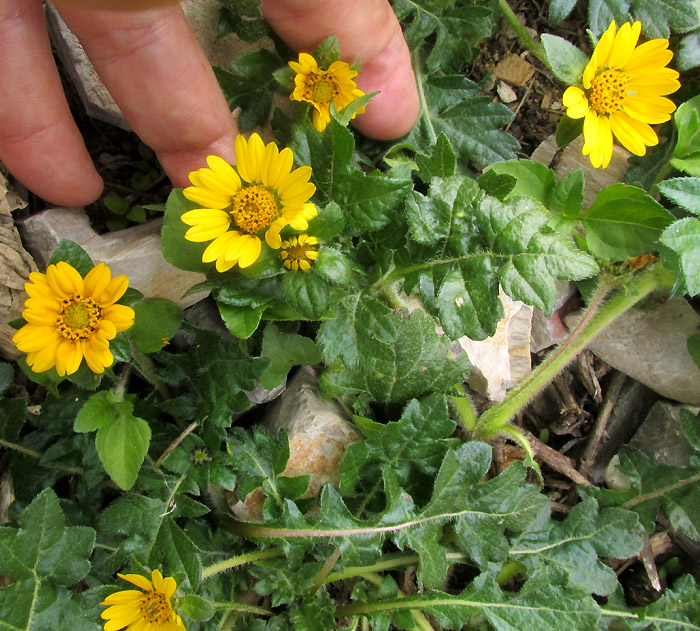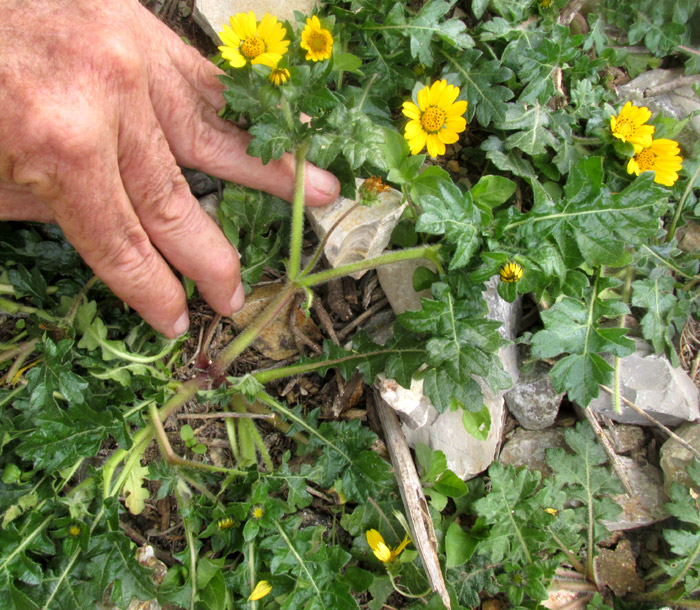Excerpts from Jim Conrad's
Naturalist Newsletter
Entry from field notes dated August 30, 2023, taken in Los Mármoles National Park, Hidalgo state, MÉXICO, about 1km upslope along road heading eastward out of the town of Trancas {on maps designated "Morelos (Trancas)"} toward Nicolás Flores; limestone bedrock; elevation ±2,100m (6900ft); (N20.80253°, W99.25756°)
DUGESIA MEXICANA

During a whole week of botanizing in the mountains along the southern border of Los Mármoles National Park, no plant was as ubiquitously conspicuous -- mostly along narrow, weedy roads -- as the one pictured above. With its flowering head "eyes" composed of many tiny disc florets with cylindrical corollas, and with petal-like, flat ray florets radiating from the center, it's clearly a member of the largest of all plant families, the Composite/Aster/Daisy/Sunflower Family, the Asteraceae. And no combination of colors and structures within that family is more typical than producing both yellow disc and ray florets. With so many members of the family sharing these features, for identification, usually you have to take a big breath, and "do the botany."

Up close, a flowering head, or capitulum, already reveals certain field marks helpful for identification. Above, most interesting is that individual, petal-like ray floret ligules are so deeply indented at their tips that at first they look like two ligules, not one. In this family, usually an important feature to determine is whether all the florets are fertile, or just the ray florets, or just the disc florets. Without good magnification, often that's hard to see. Above, conspicuous, yellow, fingerlike style arms arise from disc floret ovaries, but not from the ray florets. This might suggest that the disc florets are fertile, but the ray florets are sterile, but later on I'd find that it's just the opposite.

Above, we see some very striking, fairly important field marks distinguishing this species. First, instead of the green involucre below the gathered ray and disc florets being the typical bowl-shaped collection of overlapping scales, here the involucre is subtended by five long-hairy, leafy bracts. Between and above each pair of large, lower bracts there's a smaller bract, which arises directly below a ray floret. Also, the undersurfaces of the ray floret ligules are ornamented with conspicuous, greenish veins arrayed in a distinctive pattern. This combination of features is a key to this species' identification.

The above broken-open capitulum shows that the disc floret's ovaries and developing cypselae are slender and white, and bear at their tops no hairs, spines, scales or any other kind of pappus. In the above picture, just above the disc floret leaning toward the right, there's a white but yellow-tipped, hairlike item. That's a palea, quite different looking from the papery, scale-like paleae often visible separating florets from one another. The presence of paleae is an important identification feature. Later I was to read that in this species the disc florets are functionally male, producing no cypsela-type fruit; only the ray florets are fertile, bearing both functional stamens and ovaries, thus producing cypselae. The flowers were too small and my old-man eyes too weak to see these details in the field or the photos, even with magnification, and that complicated the identification process. However, the spectacular five lower involucral bracts and veiny ray-floret undersurfaces compensated.

Leaves with their long-hairy midveins were deeply lobed, reminiscent of Dandelion blades, and of course Dandelions also are members of the big Aster Family. Also like Dandelions, these plants grew with their leaves and stems hugging the ground:

One had to look closely to see that the leaves arose singly at each stem node, not in pairs opposite one another or with three or more.
All the above details led to DUGESIA MEXICANA, with no English name, since it's endemic just to upland east-central Mexico. This limited distribution surprised me, for at our location the species was so abundant along roads and in pastures. Usually such commonly occurring weeds are invasive species often found in many countries. The Flora del Bajío describes the species as being documented only from higher elevations of the Mexican states of San Luis Potosí, Michoacán, Mexico, Puebla, Tlaxcala, Veracruz, Querétaro, and here in Hidalgo.
Not only is Dugesia mexicana narrowly endemic, but also it's the only species in its genus. The genus Dugesia is "monotypic." Despite the species' limited distribution, it's not regarded as threatened, since within its small distribution area its natural habitat is disturbed environments, and there's plenty of those in upland central Mexico. Before the arrival of humans, the species must have specialized in occupying tree-fall areas, burnt zones,and such.
In fact, in the year 2000 Jennifer Clevinger and José Panero published their study entitled "Phylogenetic analysis of Silphium and subtribe Engelmanniinae (Asteraceae: Heliantheae) based on ITS and ETS sequence data," in which the genus Dugesia and two other genera were described as "paleoendemic relicts isolated in the mountains of Mexico." Paleoendemic relicts are species that formerly were widespread but now are restricted to a smaller area. The study further found Dugesia to be a sister genus -- arising from a common immediate ancestor -- to the genus Rojasianthe, which is a monotypic genus from southern Mexico and Guatemala. The authors hypothesized that after Dugesia and Rojasianthe evolved, their descendants spread northward well into the US, adapting as they migrated to significantly different habitats. One of those descendants eventually acquiring US citizenship was the Starry Rosinweed, which to this day retains its ancestor's outlandish lower involucral bracts, strong ray-floret ligule veins, as well as sterile disc florets and fertile, cypsela-producing ray florets.
The 2012 study by José Luis Molina-Mendoza and others entitled "Plantas Medicinales y Listado Florístico Preliminar del Municipio de Huasca de Ocampo, Hidalgo, México" tells us that here in Hidalgo Dugesia mexicana is used in traditional medicine for babies who develop diarrhea associated with toothing, as well as for toothache, stomachaches and kidney pains. In Hidalgo people call our plant hierba del puerco, or "pigweed."